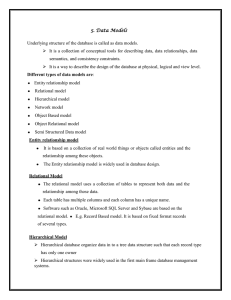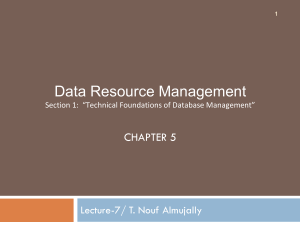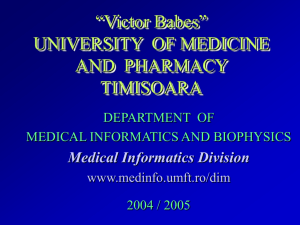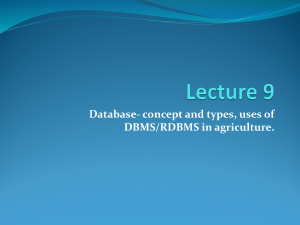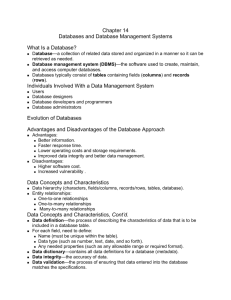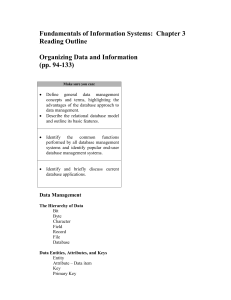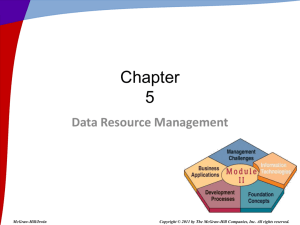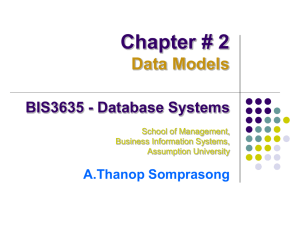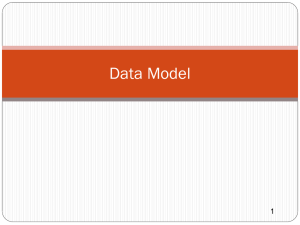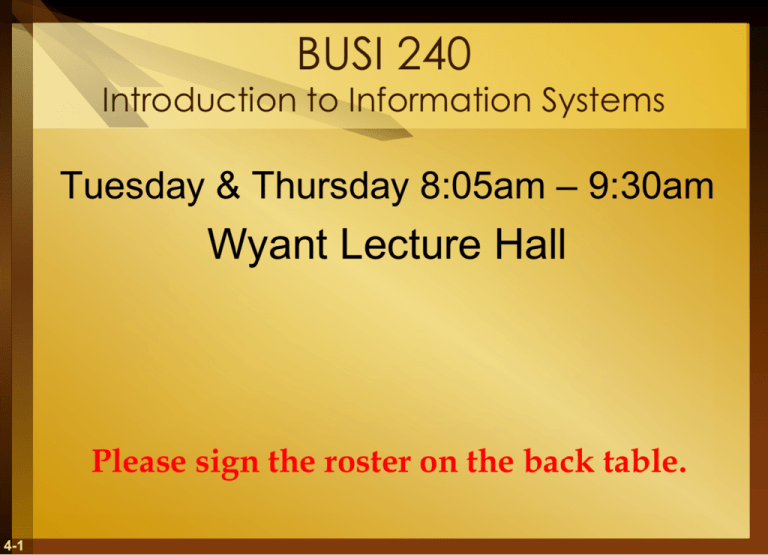
BUSI 240
Introduction to Information Systems
Tuesday & Thursday 8:05am – 9:30am
Wyant Lecture Hall
Please sign the roster on the back table.
4-1
Current Events – What’s going on?
AOL’s Bet on Another Makeover
AOL is trying to remake itself, yet again.
The new strategy in many ways resembles the old strategy: make
acquisitions to attract traffic and reverse a continuing decline in
advertising and revenue from its dial-up Internet service. In the
latest iteration of its do-over, it is paying $315 million to buy the
liberal news commentary site The Huffington Post, not long after
paying $25 million to buy TechCrunch, the Silicon Valley
technology news blog.
http://www.nytimes.com/2011/02/08/technology/08aol.html?_r=2&ref=technology
5-2
Current Events – What’s going on?
Verizon Has Already Sold 500,000 iPhones
Estimates place the number of iPhone 4s sold by Verizon Wireless
during its short-lived pre-sale at more than half a million.
function showDesc(img) { var element =
document.getElementById("videoBoxDisplayAreaText");
if(element) element.innerHTML = img.alt; };
JPMorgan analyst Phil Cusick said in a note to clients today that
it's likely 500,000 people purchased an iPhone 4 from Verizon
Wireless during the 17-hour-long pre-sale that took place on
February 3.
In order to reach this estimate, Cusick looked back at some clues
given by Verizon Wireless in the past.
http://www.informationweek.com/blog/main/archives/2011/02/verizon_has_alr.html
5-3
Quiz #2
Should have been taken by now.
5-4
Assignment #2
Select a product to evaluate:
4-5
Digital camera
Cell phone
MP3 player
Car
Computer
Follow the steps on the spreadsheet to evaluate
three models of the product
Due February 22nd
Submit assignment to eComanion’s Drop Box
Assignment #2
Web
sites with product reviews:
www.cnet.com
www.consumerreports.org
www.consumersearch.com
www.epinions.com
review.zdnet.com
www.consumerreview.com
5-6
Chapter
5a
Data Resource Management
Data Concepts
Database Management
Types of Databases
McGraw-Hill/Irwin
Copyright © 2007 by The McGraw-Hill Companies, Inc. All rights reserved.
Examples of logical data elements
5-8
Fundamental Data Concepts
5-9
Character: single alphabetic, numeric or other symbol
Field or data item: a grouping of related characters
Represents an attribute (a characteristic or quality) of some
entity (object, person, place or event)
Example: salary
Record: grouping of all the fields used to describe the attributes
of an entity
Example: payroll record with name, SSN and rate of pay
Fundamental Data Concepts
5-10
File or table: a group of related records
Database: an integrated collection of logically related data
elements
Electric Utility Database
Source: Adapted from Michael V. Mannino, Database Application Development and Design
(Burr Ridge, IL: McGraw-Hill/Irwin, 2001), p. 6.
5-11
Database Structures
5-12
Hierarchical
Network
Relational
Object-oriented
Multidimensional
Hierarchical Structure
Early
DBMS structure
Records arranged in tree-like structure
Relationships are one-to-many
5-13
Hierarchical Structure
5-14
Network Structure
Used in
some mainframe DBMS packages
Many-to-many relationships
5-15
Network Structure
5-16
Relational Structure
5-17
Most widely used structure
Data elements are viewed as being stored in tables
Row represents record
Column represents field
Can relate data in one file with data in another file if both files
share a common data element
Provide more flexibility than hierarchical databases because
they allow users to easily receive information in response to ad
hoc queries.
Relational Structure
5-18
Relational Operations
Select:
Create
a subset of records that meet a stated criterion
Example, select employees who make more than
$30,000
Join
Combine
two or more tables temporarily
Looks like one big table
Project
Create
5-19
a subset of columns in a table
Multidimensional Structure
Variation
of relational model
Uses multidimensional structures to organize data
Data elements are viewed as being in cubes
Popular for analytical databases that support Online
Analytical Processing (OLAP)
5-20
Multidimensional Model
5-21
Object-oriented Structure
Object
consists of
Data
values describing the attributes of an entity
Operations that can be performed on the data
Encapsulation:
Combine
data and operations
Inheritance:
New
objects can be created by replicated some or all of
the characteristics of parent objects
5-22
Object-oriented Structure
Source: Adapted from Ivar Jacobsen, Maria Ericsson, and Ageneta Jacobsen, The Object Advantage: Business Process
Reengineering with Object Technology (New York: ACM Press, 1995), p. 65.
Copyright @ 1995, Association for Computing Machinery. By permission.
5-23
Object-oriented Structure
Used in
Object-oriented database management
systems (OODBMS)
Supports complex data types
Examples,
5-24
graphic images, video clips, web pages
Evaluation of Database Structures
Hierarchical
Worked
for structured routine transaction processing
Can’t handle many-to-many relationships
Network
More
flexible than hierarchical
Unable to handle ad hoc requests
Relational
Easily
respond to ad hoc requests
Easier to work with and maintain
Not as efficient or quick as hierarchical or network
5-25
Database Development
Database
In
Data
Administrator (DBA)
charge of enterprise database development
Definition Language (DDL)
Develop
and specify the data contents, relationships
and structure
These specifications are stored in data dictionary
Data
dictionary
Data
base catalog containing metadata
Metadata – data about data
5-26
Database Development
5-27
Data Planning Process
Enterprise
Model
Defines
basic business process of the enterprise
Defined by DBAs and designers with end users
Data
Modeling
Relationships
between data elements
Entity Relationship Diagram (ERD) common tool for
modeling
5-28
Entity Relationship Diagram
5-29
Database Design Process
Logical
design
Schema
– overall logical view of relationships
Subschema – logical view for specific end users
Data models for DBMS
Physical
How
design
data are to be stored and accessed on storage
devices
5-30
Logical and Physical Database
Views
5-31


